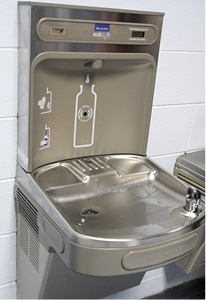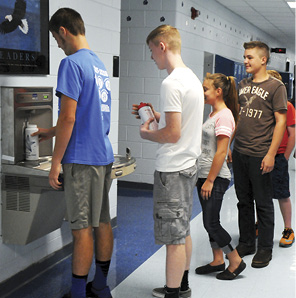Obesity prevention is one goal of new water stations at schools


Water breaks for students have always been an important necessity at schools.
Decades ago during the era of one-room schools, water was dipped from on-site wells or hand pumped into buckets. Those wells were later replaced with water fountains attached to walls inside school buildings and in more recent years, water breaks meant buying bottled water from a vendor or machine.
Through it all, the importance of drinking plenty of water during the day has been the constant in the equation, and while the process hasn’t hardly traveled full circle to the days of retrieving water from wells, at Clinton County schools, the options have again found a focus on those wall based water fountains – with a new twist.
Clinton County Extension Agent Christy Nuetzman, working with the Center for Disease Control and it’s Obesity Prevention Grant Program, has recently completed the installation of two new water fountains at each Clinton County school that not only offer students a much colder drink of water, but also feature the option to fill refillable bottles that students can carry with them.
The lot of water bottle chilling fountains purchased with the grant funds have an estimated value of approximately $11,000.
Nuetzman told the Clinton County News this week during a visit to Clinton County Middle School to show off the new water fountain, that these new appliances are just one of several programs being provided for here by the CDC Obesity Prevention Grant as a way to enhance physical activity and healthy eating throughout the county.
In addition to the new water fountains, the grant funds have purchased a Fit Trail that has been installed near the walking trail at Mountain View Recreation Park, as well as safety fencing around the early childhood playground at the park.
It’s all designed as ways to offer healthier lifestyle choices with a focus on the county’s younger population.
According to information provided about the CDC Grant premises by Nuetzman, there is growing research which indicates that trends in the childhood obesity epidemic have been paralleled by increases in the consumption of sugar-sweetened beverages during childhood.
Therefore, efforts to decrease consumption of soft drinks and other sugar-sweetened beverages and increase water consumption is key. The Journal of the American Medical Association reports that adding drinking dispensers in schools may have a positive effect on student weight.
Water is vital to our health. The water bottle chilling stations provide students with access to filtered cold drinking water throughout the day. The fountains operate much like a traditional water fountain with front and sidebar access, but they offer sanitary, touchless activation bottle filler with an automatic 20-second shut-off.
In addition, each fountain has a display which includes an Innovative Green Ticker™ which counts bottles saved from waste.
During the short stay that the NEWS reporter was observing the fountain at Clinton County Middle School, even students who were just drinking from the fountain’s standard water flow were standing in line and overwhelmingly choosing the new filtered cold water stations while the older normal water fountains sat idle for the most part.
“School staff who support students having access to water throughout the day are reinforcing the message that health matters and modeling to students that making the healthy choice the easy choice isn’t as difficult as most people may think,” Nuetzman told the Clinton County News.
Clinton County School Superintendent Charlotte Nasief told the Clinton County News that she was thankful that Nuetzman had worked so hard to acquire the drinking stations for the Clinton County schools and also praised her for her work to benefit the schools and students in other programs as well.
“These hare a good design for giving the students the opportunity to lead a healthy lifestyle and to be sure they are drinking enough water throughout the day,” Nasief said. “I’ve heard a lot of positive comments from parents since the stations have been installed.”
Teresa Scott, Principal at Clinton County Middle School, told the Clinton County News she was thrilled that Nuetzman had worked to see that the grant funds were spent toward the installation of the fountains at her school, adding she wished additional funds would become available to allow for even more of the chilling stations to be added for students.
She also pointed out that the availability of the new water source meant that students weren’t having to spend money on bottled water.
Scott pointed out that most people would be shocked at the number of students at her school who simply couldn’t afford to purchase bottled water from vending machines.
Tim Armstrong, principal at Albany Elementary School, also pointed out the advantages and extra health benefits he believes his young students are now getting because of the new stations.
“I am thankful to have the water bottle refill feature added to fountains,” Armstrong said. “Students are now afforded extra opportunities to drink more water and keep their bodies hydrated for optimal performances.”
With one of its goals being to prevent childhood obesity and in doing so raise the level of health of these students throughout their adult lives by teaching better eating habits at a young edge, Nuetzman explained the thinking behind offering a water option to the students and hopefully replacing some of the consumption of soft drinks.
To lose weight, you must take in fewer calories than your body uses. Most people focus on monitoring calories from foods. However, calories from drinks can really add up.
“That’s why we encourage people to rethink their drink options,” Nuetzman said.
Nuetzman has conducted “Rethink Your Drink” education in our schools for a number of years.
“Students and adults are always amazed when they see the visuals that show exactly how much sugar is in some of the more popular drinks and snacks often consumed by our students,” she explained “On average, there’s 14-18 teaspoons of sugar in a 20 oz. soda. It’s an eye-opener for sure.”
She also pointed out that her education programs also focus not only on a healthier diet and the benefits, but also the importance of combining that proper diet with exercise and physical activity that is designed to enhance one’s health.
“We also talk about how long we need to be active to balance the number of calories we consume,” Nuetzman explained. “For example, one handout we share with students reminds them that to burn the calories of one 20 oz. soda, they would need to walk briskly for almost 50 minutes.”
Nuetzman further explained that the combination of factors work in conjunction to raise the level of health of those who become aware of making the necessary changes
“There’s lots of empty calories in drinks which can lead to excess weight if you’re not willing to get up and move,” Nuetzman said. “Activity matters too.”
Taking the concept of more water, less sugar a step further, Nuetzman said that soft drinks and sugar enhanced juices weren’t the only culprits that the program was hoping to see a reduction in consumption quantities.
“We’ve got to make drinking water a more routine part of children’s health, and adults for that matter. We’re not just talking about decreasing the number of soft drinks or sweetened juice drinks,” Nuetzman said. “It’s concerning how many young students also report that they drink energy drinks on a regular basis. I’m not sure how they get their hands on them, other than finding them in the fridge already, but I’m constantly reminding students that no good can come from drinking them. We all need to drink more water.”



